Timberland boots are coveted functional footwear, despite initially being invented for the purpose of work wear in 1973. This iconic brand has also garnered a following in streetwear fashion thanks to the striking look of the classic boot and the range of designs the brand has to offer.
If you haven’t had the chance to try on a pair for yourself though, you may be wondering ‘do Timberlands run big’? It’s important to know that certain styles of Timberlands run big and are different in size from standard shoe sizes.
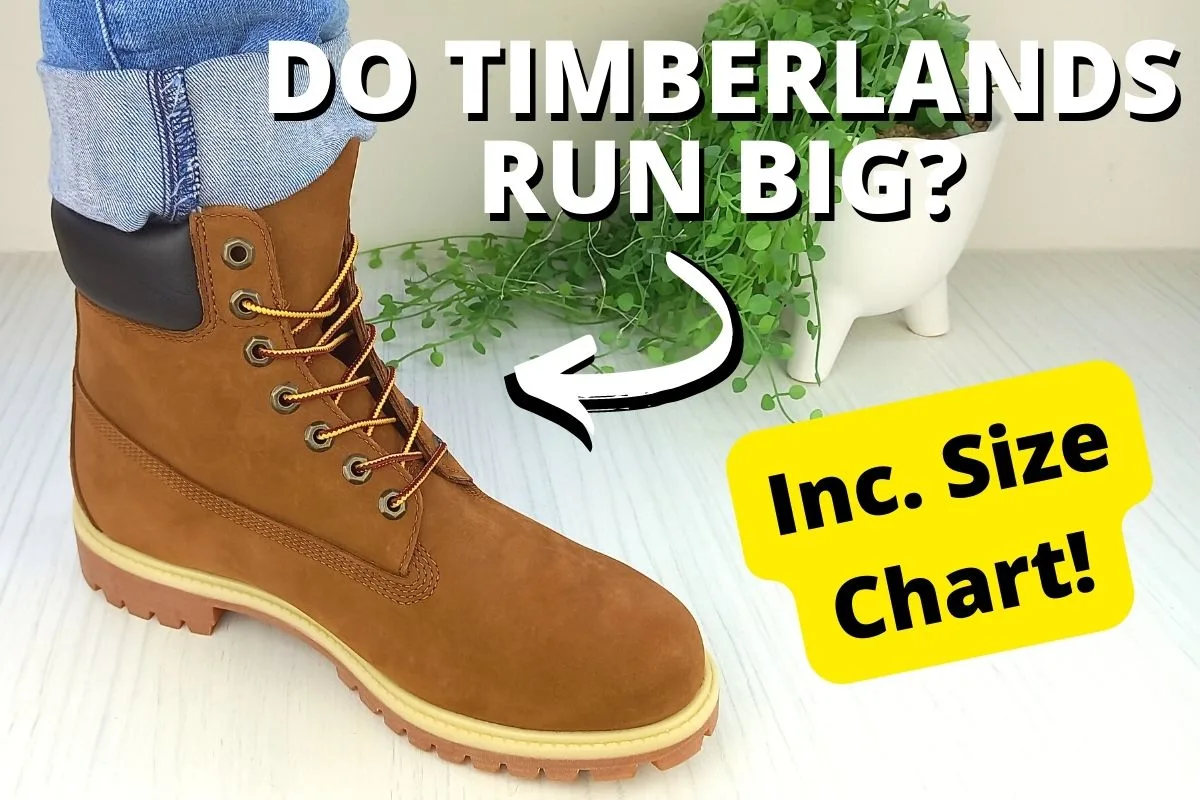
Timberlands run big; the PRO boots, Premium 6” Waterproof boots, the Mt Maddsen and Hiking boots are generally larger than standard sizes. When buying these designs buy at least ½ size smaller if you don’t want a roomy fit. Other ranges such as the Women’s and Kid’s styles, Pitboss Boots, sneakers and shoes fit truer to size.
Timberland also offer a 30 days returns policy if you buy them from their official store here, so don’t panic if you’re worried about them not fitting quite right. There is plenty of time to get a good fit.
I have also included a comprehensive sizing chart in this article to assist you with the perfect fit, you you can get it right first time and avoid the hassle of returns.
If you are a regular Timberland wearer, you’ll have a good idea of the fit, but as a newbie, sizing can be tricky. Fortunately, I am here to help you out in this article. I’ll be including my long term experience wearing Timberlands, plus photos and a video of me in my boots so you can get a good look at how they fit.
*This page may contain affiliate links. As an Amazon Associate I earn from qualifying purchases at no additional cost to you. Learn More.
Consider Style Sizes Before Buying Your Timberlands
Timberland boots are known to run big, and the average size difference between a Timberland boot and a normal-sized shoe is half a size.
Styles that run big, according to customer reviews on the Timberland site, include:
- Timberland Premium 6″ Waterproof boot
- Timberland PRO boots
- Timberland site Mt Maddsen boots
- Hiking boots
Here’s a video of how my Timberlands fit me:
In my experience too the Timberland Premium 6″ Waterproof boots do run a little big. Here’s how they look on me:
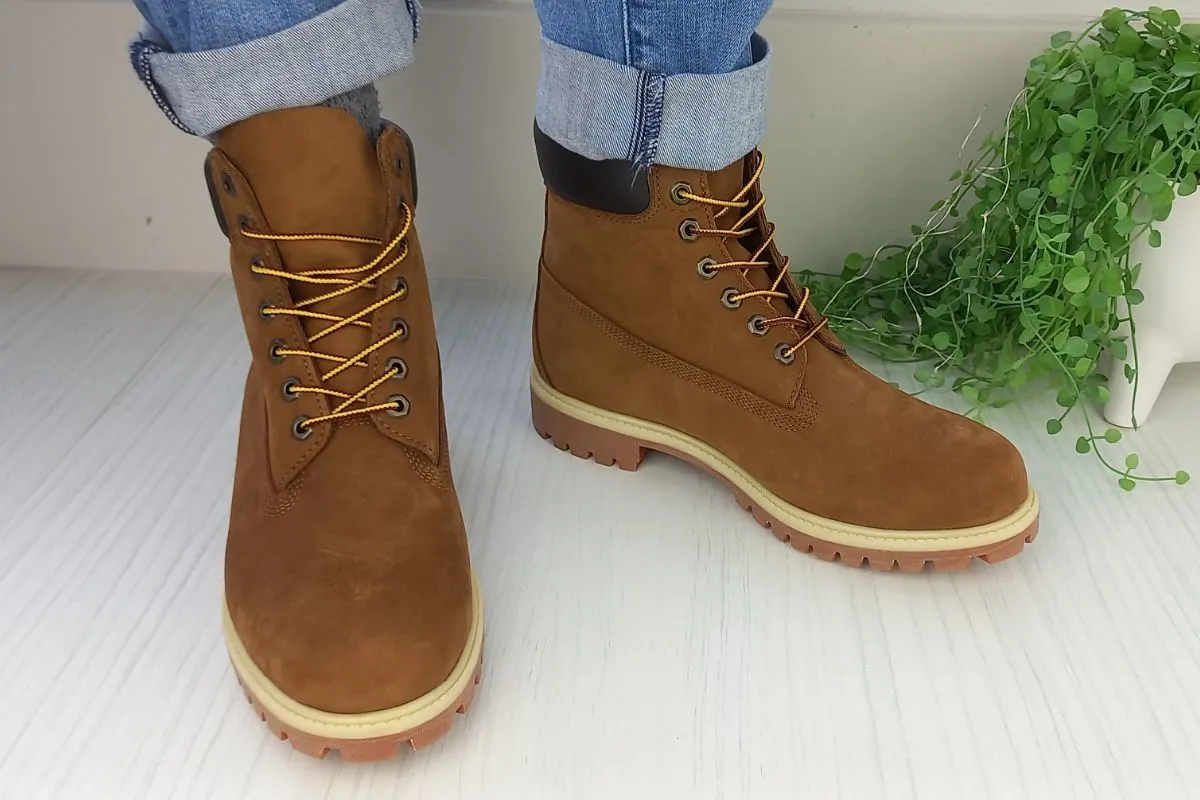
There’s plenty of room in the toe box which I really like. If you enjoy a roomy fit and plan to wear your Timberlands with thick socks, this is a huge plus.
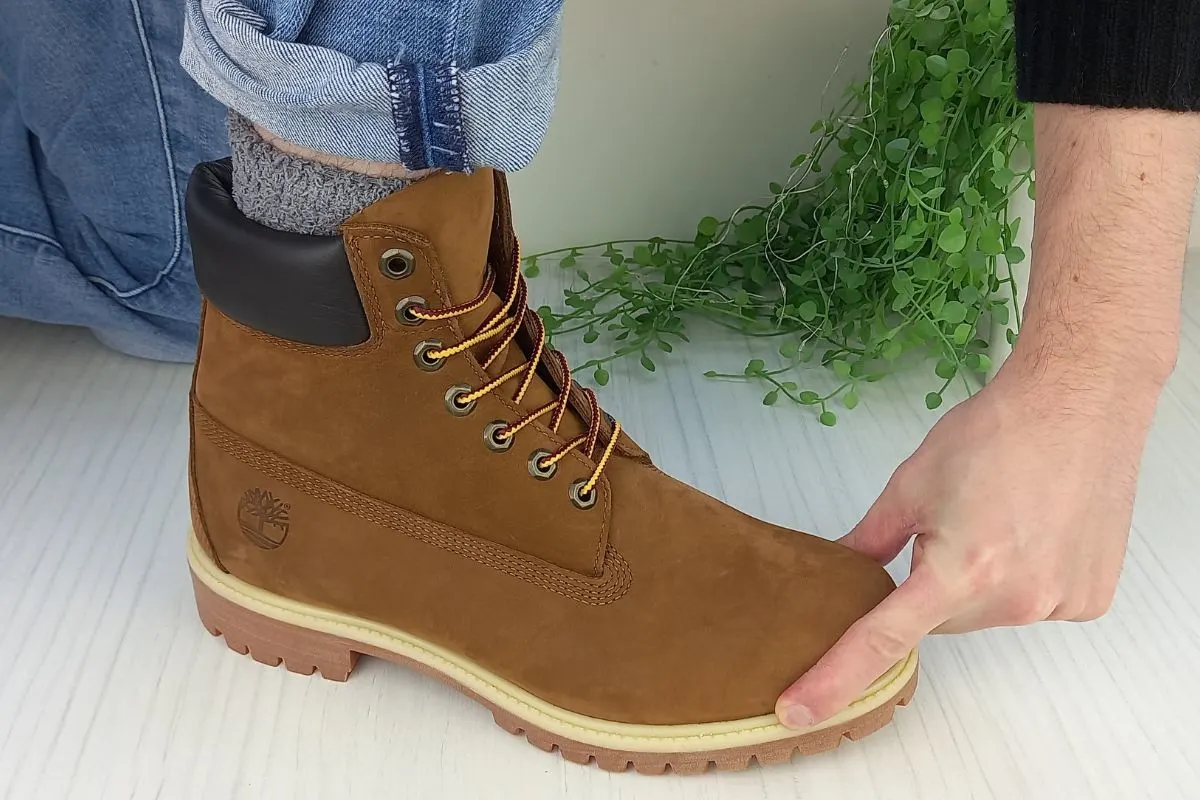
They also fit nicely around the ankle thanks to the padded collar. It’s not too tight or loose and fits just right.
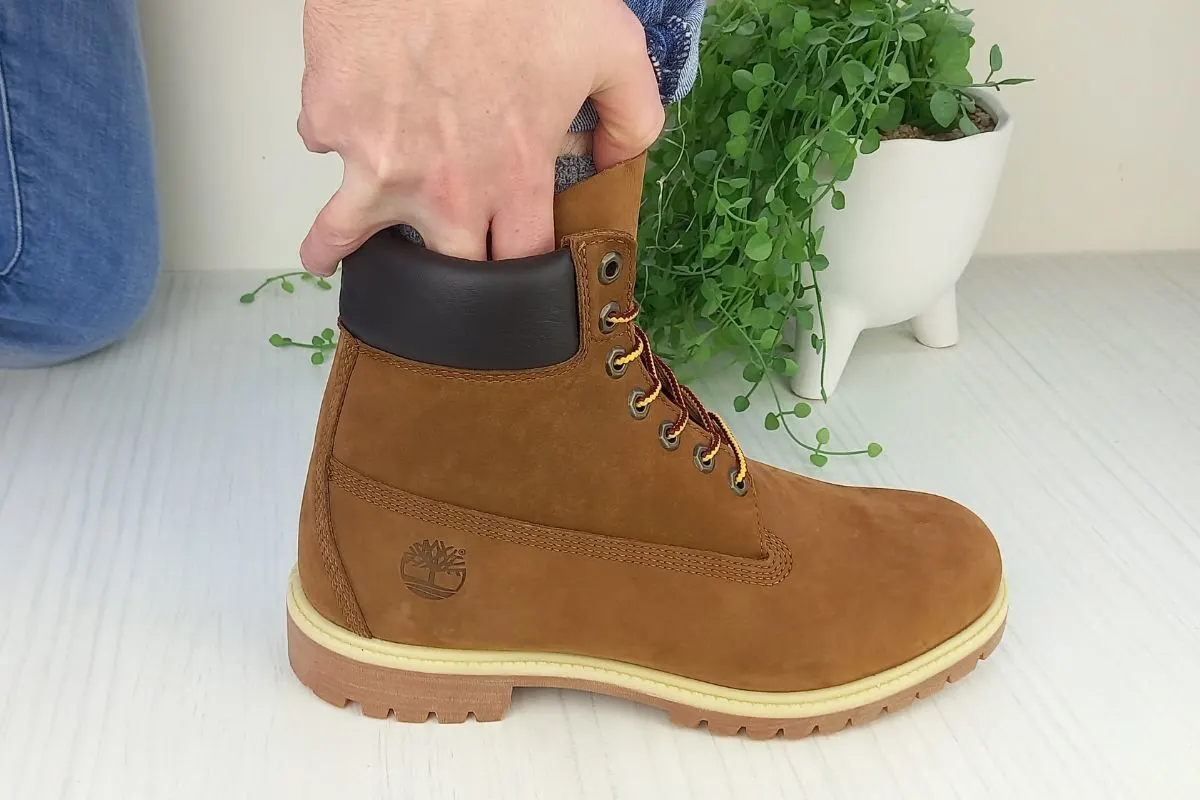
Get your own pair of the classics here.
The Timberland range of shoes has expanded to include shoes and sneakers and a children’s range. More recent shoes in the collection are truer in size.
Timberland customers generally rate the following as true to size or marginally bigger:
- Workboot range
- Sneakers
- Shoes
- Pitboss boots, although they may feel a bit tight if your feet are wide
- Women’s Range
- Kid’s shoe range
Walk Around in Your Timberland Shoes Before Buying Them
The best bet when buying your Timberlands is to try them on and walk around in the shoe store before making a purchase. Ideally, you should wear the same socks you’ll wear with your shoe to get the most comfortable fit.
The challenge is that you don’t get to do this with online shopping. An exact foot measurement is the next best option. Fortunately, Timberland provides a measurement chart on its website Timberland.com. Measure your foot later in the day and with the socks you intend to use with the boots.
If you buy a pair of Timberlands online, each shoe has a shoe and fit review that rates sizes from customers’ perspectives so you’ll have even more information to inform your choice.
Timberland Boots Should Fit Snugly
Your Timberland boots should ideally fit snugly around your entire foot but not pinch or rub your foot. The heavier, chunkier models run big because of their ruggedness and weight, and it is best to buy them half a size smaller.
Because Timberlands are constructed for durability, they are not soft and pliable when you buy them; leather stretches, but you will have to bear with some pinching and friction for a while.
The best way to find a good fit is to loosen the laces of the boot and push your foot right to the front of the boot. With your toes touching the front of the boot, there should be a ½ inch gap between your heel and the back section of the shoe to give your toes some wriggle room.
Timberlands Do Stretch
One of the features of Timberlands is that most ranges are made from either Nubuck or full-grain leather. Both nubuck leather and full-grain leather stretch, so shoes that are too big can stretch even further when the leather relaxes. Consider this when buying your shoes.
Nubuck leather is stretchy and doesn’t require much effort to break in. It is made from the inside of the hide, is filed down, and has a smoother, softer texture but is still durable.
On the other hand, full-grain leather is tougher and made from the outer layer of the hide. Much of the Timberland men’s boot range is constructed from full-grain leather, and breaking in requires more effort. Boots with thick soles also take some getting used to.
Take Correct Foot Measurements
Measuring your foot is simple, but you must be meticulous. Start by placing your feet on a piece of paper.
Stand on a hard surface to get the most accurate measurement. A fraction of an inch makes a difference when wearing shoes, and softer surfaces may compress your foot’s outline.
Place your weight on the paper as you would when you stand with your feet planted on the ground. Enlisting the help of a friend to draw the shape of your foot provides the most accurate measurement. Remember to wear the socks you plan to wear with your shoes.
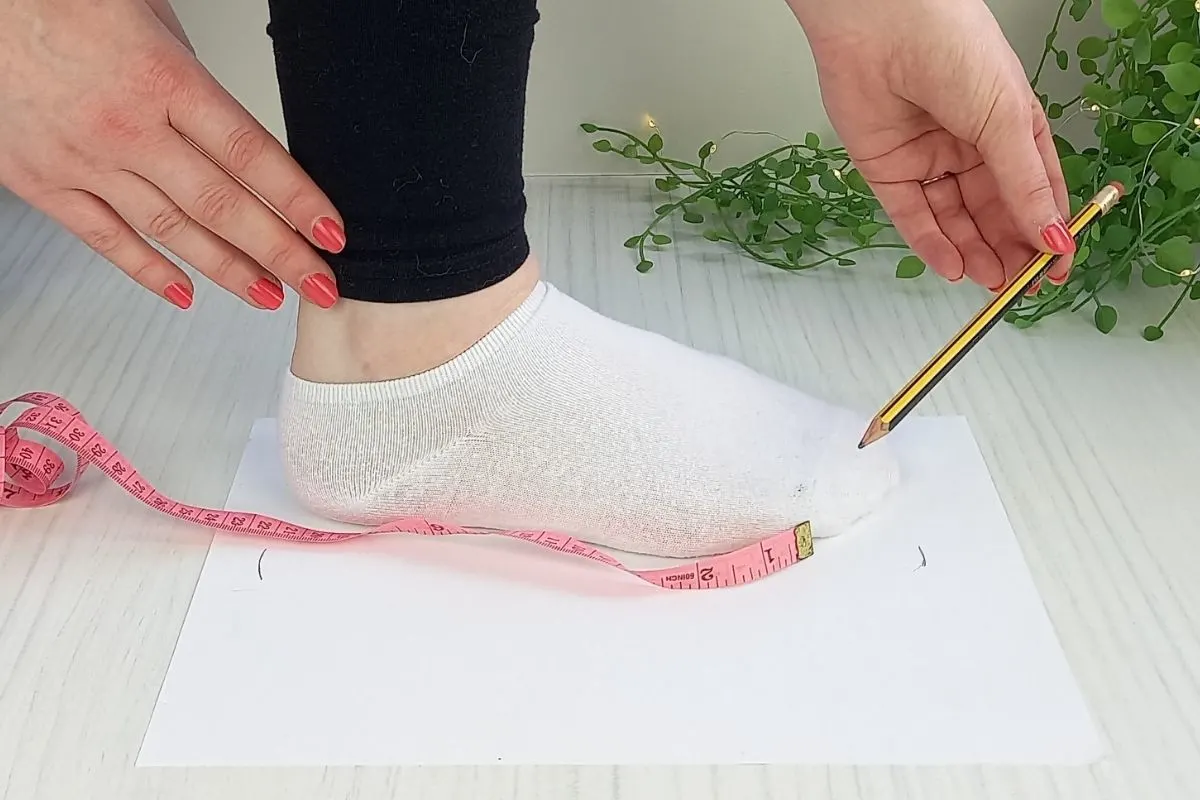
When you have the shape of your feet, measure from the longest toe to the end of the heel. Check the length of both feet, as one foot could be longer than the other. Always choose your shoe size according to your biggest foot.
Take into account that your toes and heels shouldn’t be crammed against the edges of the shoe, so draw completely around the outer edge of your foot, and don’t let your pencil sneak under any gaps. Also, ensure that your toes are completely pressed down and stretched out as they would be in a shoe.
Once you have your measurement write it down in cm and inches, and use it to find your size on the sizing charts in this article (keep scrolling to see them).
Width Is Important When Selecting A Size
Measuring the width of your foot is just as important as getting the length right. The difficulty with gauging width is that there is no standard guide, and sizes vary from brand to brand. There is a 1/8th inch difference between widths, and half sizes are wider.
Unfortunately, Timberland.com does not provide width measurements, but there are resources online that do give guidance.
Timberlands aren’t suitable for narrow feet, but if they are a must-have for you, there are ways to make them fit. Men’s Timberlands are available in regular and wide fit, with some boots going as big as extra wide. The women’s range only offers medium width.
If your feet aren’t particularly broad and you plan to buy one of the older generation Timberlands, stick to regular width or buy a ½ size smaller.
To measure the width of your foot, measure across the widest part, which is generally just below the base of your toes where your bunion would be. Measure both feet and use the widest measurement. When deciding your size, be on the safe side and round the numbers up, not down.
A useful way to determine whether your Timberland width fits correctly is to look at how the laces fit. Laces should be comfortable with a ½ inch gap between them. If you need to lace them tighter or looser, your shoe fit is incorrect.
Timberland Sizing Charts
What’s useful about the Timberland size charts is that they indicate sizes from various countries and regions and show measurements in inches and centimeters. Centimeters provide a more accurate size as the increments are smaller than inches. When rounding a shoe size up to fit your foot centimeters, ensure less margin for error.
The sizing chart covers an entire size range from newborn to men’s sizes in specific detail. Size varies for men, women, and children. For instance, a man’s size 9 has different dimensions than a woman’s.
Timberland has an Infant to Junior Footwear size chart, which provides measurements from birth to 13 years. The website also offers a unique measuring guide for this age group that is a downloadable sheet with step-by-step instructions to find the correct size for your child.
The Timberland website also provides a Timberland PRO Footwear Size Chart. The sizes for PRO Footwear run slightly bigger than standard men’s and women’s sizes and cater to larger feet.
Men’s Pro Footwear Sizes
| USA | EU | UK | INCH | CM |
| 6.5 | 38.5 | 5.5 | 9.48 | 25 |
| 7 | 39 | 6 | 9.48 | 25 |
| 7.5 | 40 | 6.5 | 10.24 | 26 |
| 8 | 41 | 7 | 10.24 | 26 |
| 8.5 | 41.5 | 7.5 | 10.43 | 26.5 |
| 9 | 42.5 | 8.5 | 10.63 | 27.5 |
| 9.5 | 42.5 | 8.5 | 10.83 | 27.5 |
| 10 | 43 | 9 | 11.02 | 28 |
| 10.5 | 43.5 | 9.5 | 11.22 | 28.5 |
| 11 | 44 | 10 | 11.42 | 29 |
| 12 | 46 | 11 | 11.81 | 30 |
| 13 | 47 | 12 | 12.2 | 31 |
| 14 | 48 | 13 | 12.6 | 32 |
| 15 | 49 | 14 | 12.99 | 33 |
| 16 | 50 | 15 | 13.39 | 34 |
| 17 | 51 | 16 | 13.78 | 35 |
| 18 | 52 | 17 | 14.17 | 36 |
| 19 | 53 | 18 | 14.57 | 37 |
| 20 | 54 | 19 | 14.96 | 38 |
Women’s Pro Footwear Sizes
| USA | EU | UK | INCH | CM |
| 5 | 35 | 2.5 | 8.66 | 22 |
| 5.5 | 36 | 3 | 8.86 | 22.5 |
| 6 | 36.5 | 3.5 | 9.06 | 23 |
| 6.5 | 37 | 4 | 9.25 | 23.5 |
| 7 | 37.5 | 4.5 | 9.45 | 24 |
| 7.5 | 38 | 5 | 9.45 | 24 |
| 8 | 38.5 | 5.5 | 9.84 | 25 |
| 8.5 | 39 | 6 | 9.84 | 25 |
| 9 | 40 | 6.5 | 10.24 | 26 |
| 9.5 | 41 | 7 | 10.24 | 26 |
| 10 | 43 | 9 | 11.02 | 27 |
| 11 | 43 | 9 | 11.42 | 29 |
| 12 | 44 | 10 | 12.6 | 32 |
Men’s Size Chart
| USA | EU | UK | INCH | CM |
| 5 | 37.5 | 4.5 | 9.3 | 23.5 |
| 5.5 | 38 | 5 | 9.4 | 24 |
| 6 | 39 | 5.5 | 9.4 | 24 |
| 6.5 | 39.5 | 6 | 9.6 | 24.5 |
| 7 | 40 | 6.5 | 9.8 | 25 |
| 7.5 | 41 | 7 | 10 | 25.5 |
| 8 | 41.5 | 7.5 | 10.2 | 26 |
| 8.5 | 42 | 8 | 10.4 | 26.5 |
| 9 | 43 | 8.5 | 10.6 | 27 |
| 9.5 | 43.5 | 9 | 10.8 | 27.5 |
| 10 | 44 | 9.5 | 11 | 28 |
| 10.5 | 44.5 | 10 | 11.2 | 28.5 |
| 11 | 45 | 10.5 | 11.4 | 29 |
| 11.5 | 45.5 | 11 | 11.6 | 29.5 |
| 12 | 46 | 11.5 | 11.8 | 30 |
| 13 | 47.5 | 12.5 | 12.2 | 31 |
| 14 | 49 | 13.5 | 12.6 | 32 |
| 15 | 50 | 14.5 | 13 | 33 |
Women’s Size Chart
| USA | EU | UK | INCH | CM |
| 5 | 35.5 | 3 | 8.7 | 22 |
| 5.5 | 36 | 3.5 | 8.9 | 22.5 |
| 6 | 37 | 4 | 9.1 | 23 |
| 6.5 | 37.5 | 4.5 | 9.3 | 23.5 |
| 7 | 38 | 5 | 9.5 | 24 |
| 7.5 | 38.5 | 5.5 | 9.6 | 24.5 |
| 8 | 39 | 6 | 9.8 | 25 |
| 8.5 | 39.5 | 6.5 | 10 | 25.5 |
| 9 | 40 | 7 | 10.2 | 26 |
| 9.5 | 41 | 7.5 | 10.4 | 26.5 |
| 10 | 41.5 | 8 | 10.6 | 27 |
| 11 | 42 | 9 | 11 | 28 |
Infant to Junior Size Chart
| USA | EU | UK | INCH | CM |
| 0 | 15 | 0 | 3 | 8 |
| 1 | 16 | 0.5 | 3.6 | 9 |
| 2 | 17 | 1.5 | 3.7 | 9.5 |
| 2.5 | 18 | 2 | 3.9 | 10 |
| 3 | 18.5 | 2.5 | 4.1 | 10.5 |
| 3.5 | 19 | 3 | 4.3 | 11 |
| 4 | 20 | 3.5 | 4.7 | 12 |
| 4.5 | 20.5 | 4 | 4.7 | 12 |
| 5 | 21 | 4.5 | 4.9 | 12.5 |
| 5.5 | 22 | 5 | 5.1 | 13 |
| 6 | 22.5 | 5.5 | 5.3 | 13.5 |
| 6.5 | 23 | 6 | 5.5 | 14 |
| 7 | 23.5 | 6.5 | 5.5 | 14 |
| 7.5 | 24 | 7 | 5.7 | 14.5 |
| 8 | 25 | 7.5 | 5.9 | 15 |
| 8.5 | 25.5 | 8 | 6.1 | 15.5 |
| 9 | 26 | 8.5 | 6.3 | 16 |
| 9.5 | 26.5 | 9 | 6.3 | 16 |
| 10 | 27 | 9.5 | 6.5 | 16.5 |
| 10.5 | 28.5 | 10.5 | 6.9 | 17.5 |
| 11.5 | 29 | 11 | 7.1 | 18 |
| 12 | 30 | 11.5 | 7.3 | 18.5 |
| 12.5 | 30.5 | 12 | 7.38 | 18.7 |
| 13 | 31 | 12.5 | 7.5 | 19.1 |
| 13.5 | 32 | 13 | 7.88 | 19.9 |
| 1 | 33 | 1 | 8 | 20.4 |
| 2 | 34 | 1.5 | 8.13 | 20.8 |
| 2.5 | 34.5 | 2 | 8.38 | 21.2 |
| 3 | 35 | 2.5 | 8.5 | 21.6 |
| 3.5 | 35.5 | 3 | 8.7 | 22 |
| 4 | 36 | 3.5 | 8.9 | 22.5 |
| 4.5 | 37 | 4 | 8.9 | 22.5 |
| 5 | 37.5 | 4.5 | 9.1 | 23 |
| 5.5 | 38 | 5 | 9.3 | 23.5 |
| 6 | 39 | 5.5 | 9.4 | 24 |
| 6.5 | 39.5 | 6 | 9.6 | 24.5 |
| 7 | 40 | 6.5 | 9.8 | 25 |
Timberland Has A Returns Policy
Online shopping can be a challenge when buying fitted items. Shoes are no exception to this. Timberland has a lenient returns policy and makes the process simple. You will need to return your purchase within 30 days. Should you wish to return your boots or order a different size, there are three ways to do this:
- Pre-printed return labels are enclosed with all products bought from the official Timberland online store. Returns are free.
- Store-bought Timberland boots must be returned to the store you purchased them from.
- Boots purchased from an alternate website are also returnable using the free return label from the Timberland returns page.
A condition of returns is that you haven’t worn the boots outdoors, they aren’t damaged, and they still have the original packaging.
Another cool Timberland feature is the Timberland PRO® 30-Day Comfort Guarantee. You may return your boots if they are not as comfortable as you expected. One call to the Customer Service Center within 30 days of receiving your boots will provide you with a return address and details.
There Is A Solution To Timberlands That Are Too Big
Fortunately, if you have purchased your shoes and they run big or stretch, there are several ways to rectify the fit problem:
- Your first resort would be to wear thicker socks. However, in warmer weather, this may be uncomfortable.
- Another option is toe cushions. As strange as this may sound, toe cushions are comfortable once you are accustomed to wearing them.
- Heel strap pads are easy to stick on and ideal if your foot slips back and forth.
- Tongue groove pads can be inserted under the tongue of your shoe if this is a friction point.
- Using full-length orthotics or inner soles grows your feet to one shoe size.
- ¾ length orthotics work well if ½ a foot increase is all you need.
- Custom inserts molded specifically for your foot can add up to 1 ½ shoe sizes.
- Double up on insoles to lift your foot for a snugger fit.
- Lightly spray your shoe with water and walk around. This molds the shoe to your foot.
- Apply leather conditioner to your shoe and wear it. The leather conditioner has the same effect as water but is a more shoe-friendly option.
- Wear a gel pad under the ball of your foot to prevent your foot from rubbing back and forth.
- As a last resort, tissue paper or any soft material scrunched up in the toe of your shoe also does the trick.
Timberlands That Are Too Tight Can Be Stretched.
Suppose you bought your shoe ½ to 1 size smaller, and they fit too snugly after normal wearing in; you can stretch them out:
- Wear your shoes around the home for short periods, so they adjust to the shape of your foot. Using thick socks while you soften your shoes prevents blisters.
- Heat your shoes with a hairdryer and walk around in them. Take care not to burn your shoes.
- Fold, bend and twist the soles of your shoes to make them more flexible. Take care not to damage or split the soles.
- If the backs of your heel rub against the shoe, soften this part with leather conditioner and massage the back of your shoe.
- Overstuff your shoes with damp newspaper when you aren’t wearing them. The newspaper must only be slightly moist and not drenched in water.
- Freezing your shoes is another option; fill a small utility bag with water and place it in your shoe. Place your shoes in utility bags and freeze them overnight. When the water turns to ice, it expands, and so does your shoe.
- Most shoe stores sell stretchers which work wonders in expanding your shoes.
- Another nifty solution is toe rises, squats, or lunges in your shoes; this flexes the leather and sole and makes them supple.
Wearing The Wrong Size Shoe Can Damage Your Feet.
Shoes play a huge role in foot health, and wearing the wrong size can cause painful foot conditions further down the line:
- You run the risk of twisted ankles, ankle sprains, and injured calf muscles if your shoes are too big, particularly with heavily constructed boots.
- Shoes that don’t fit properly, especially oversized ones, change how you walk and put pressure on joints like your knees and ankles.
- Wearing shoes that constrict your feet causes calluses and corns, which may eventually result in neuropathy. Neuropathy causes pins and needles in your feet and loss of sensation.
- Too tight shoes deform feet and toes.
- Ingrown toenails are also a consequence of overly tightfitting footwear.
Conclusion
Timberlands are generally thought to run big; however, this applies to the larger, chunkier boots and earlier styles. New styles are most likely to match size charts that are comprehensively detailed on the Timberland website. There are ways to fill your shoe or shrink your shoe if you need to. Timberland has an excellent returns policy which is useful if your shoes run big.

Lorna is a footwear geek and the founder of Wearably Weird. She created a YouTube channel in 2021 for fellow footwear fanatics, dedicated to detail-rich footwear reviews and info. She has a fashion media qualification (awarded in 2011).
